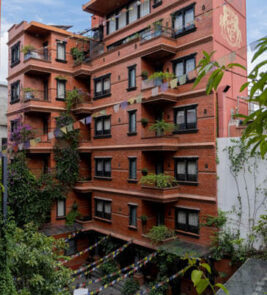Walking through the Basantapur Durbar Square a peculiarly gridded window, Aankhi Jhyal, on the second floor of one of the traditional brick houses, catches your attention. The evening sunlight beams through the small, but mighty, grids, and the dust around it almost shimmers and reflects on the intricate details of the window frames. You wonder, where such a work of ancient artifacts originates and why most traditional Newari households carry a window heavy with such generational beauty and elegance.
Chip, stud, chisel, slash. Your eyes follow the sound downstairs, and you hear the sound of blades scraping on wood from inside a wood-carving shop on the ground floor sheltering hundreds of such windows stacked above one another. A local craftsman is naturally weaving his magic, carrying on the legacy of carving more Aankhi Jhyals.
Ancient Newari craftsmanship is hard to miss in the durbar squares in and around the Kathmandu Valley. The architecture stands out as one of the most extraordinary forms of art in the world. The delicate intricacies in every corner of the carved windows or house beams carry age-old essence that has been preserved and passed down through generations.
What is an ‘Aankhi Jhyal’?
‘Aankhi’ means ‘from the eyes’, and ‘Jhyal’ means windows. Aankhi Jhyal, simply, means a window that lets you look out. But the meaning transforms as you take a closer look at how the shape is made in almost every Aankhi Jhyal. The horizontally extended upper and lower edge frame of the window and the narrowed section in the middle where the opening gracefully lies–the structure almost looks like an eye. Back in the day, people believed Aankhi Jhyal to be their eye-protector, looking out for them, and safeguarding their homes from any evil spirit out there.
History of Aankhi Jhyal
Newari people have carried the tradition of designing and carving Aankhi Jhyal for centuries. Newari art is believed to have been in existence ever since the Newar people came to be. Some cultural scriptures claim the ancestry of the caste dates back as long as two millennia. But the earliest formally documented history records from the Licchavī Era from the 5th to 9th century. The Licchavīs are believed to be descendants of Newaris.
The earliest known Aankhi Jhyal comes from the culture of this period, some even aging centuries older than that. The Newari culture was springing into the ruling families at the time. Back then, Nepal was in the golden era of flourishing art and architecture. The rulers utilized the unique artistic abilities of the Nepalese to further enhance trade strategies with other countries. Nepal was in its prosperous state at that time, and part of the credit goes to unhinged and hardworking artists and craftsmen whose works that carry irreplaceable essence were exported. Aankhi Jhyal was one of the many popularized art practices.
Many stories dance around the origin of Aankhi Jhyal. Some say, the then rulers hired local woodworkers and craftsmen to build an aesthetically unique window for their Queens, with meaningful elements carved all over, a strong build that holds itself together, and just the right amount of thickness, grid size, and design to let them look out but not let the outsiders look in. The illustration elements added a religious and spiritual meaning to it.
As the trend caught on at that time, high-class families and aristocrats, too, started keeping Aankhi Jhyak in their homes. They would hire craftsmen and order them to make entirely new and unique patterns and designs, different from everyone else’s. That is why, today, Aankhi Jhyal from different places have completely different designs.
Built and style of Aankhi Jhyal
The Aankhi Jhyal is distinguished by its intricately carved wooden frame, showcasing a pleasant blend of geometric patterns, floral emblems, and figures of deities. The thickness is pertained for privacy reasons. Often, the opening of the window has grids of different sizes, curves, and patterns. The holes allow sunlight in and also act as a proper ventilation for the room.
Aankhi Jhyal is more often placed on the second floor in a position that overlooks the activities outside the house. One of the defining features of the Aankhi Jhyal is its arched top and bottom, resembling the shape of an eye.
You will notice different structural designs in different places, attributing to the cultural diversity and the sheer beauty of taking on the unique beauty it carries.
Aankhi Jhyal at the Dalai-la Boutique Hotel
With an unwavering attempt to bring the beauty and symbolism of Aankhi Jhyal closer to you, Dalai-la Boutique Hotel is carefully designed to preserve the age-old Newari architecture. Our designs encapsulate a well-thought-out practice of incorporating traditional artisans with modern luxury, bringing the opportunity to admire the intricate beauty of Aankhi Jhyal. It is a testament to Newari architecture, showcasing a deliberate effort to bring historic wonders into the contemporary realm.
The hotel’s pillars are not mere structures; they are restorations of carvings dating back more than 50 years, embodying a commitment to heritage preservation. Each pillar and window stands as a tribute to the skilled craftsmen who have dedicated their brilliance to polishing this art form, ensuring the continuation of their ancestors’ legacy. In doing so, Dalai-la Boutique Hotel strives to safeguard the captivating beauty of Aankhi Jhyal for future generations to admire and cherish.


